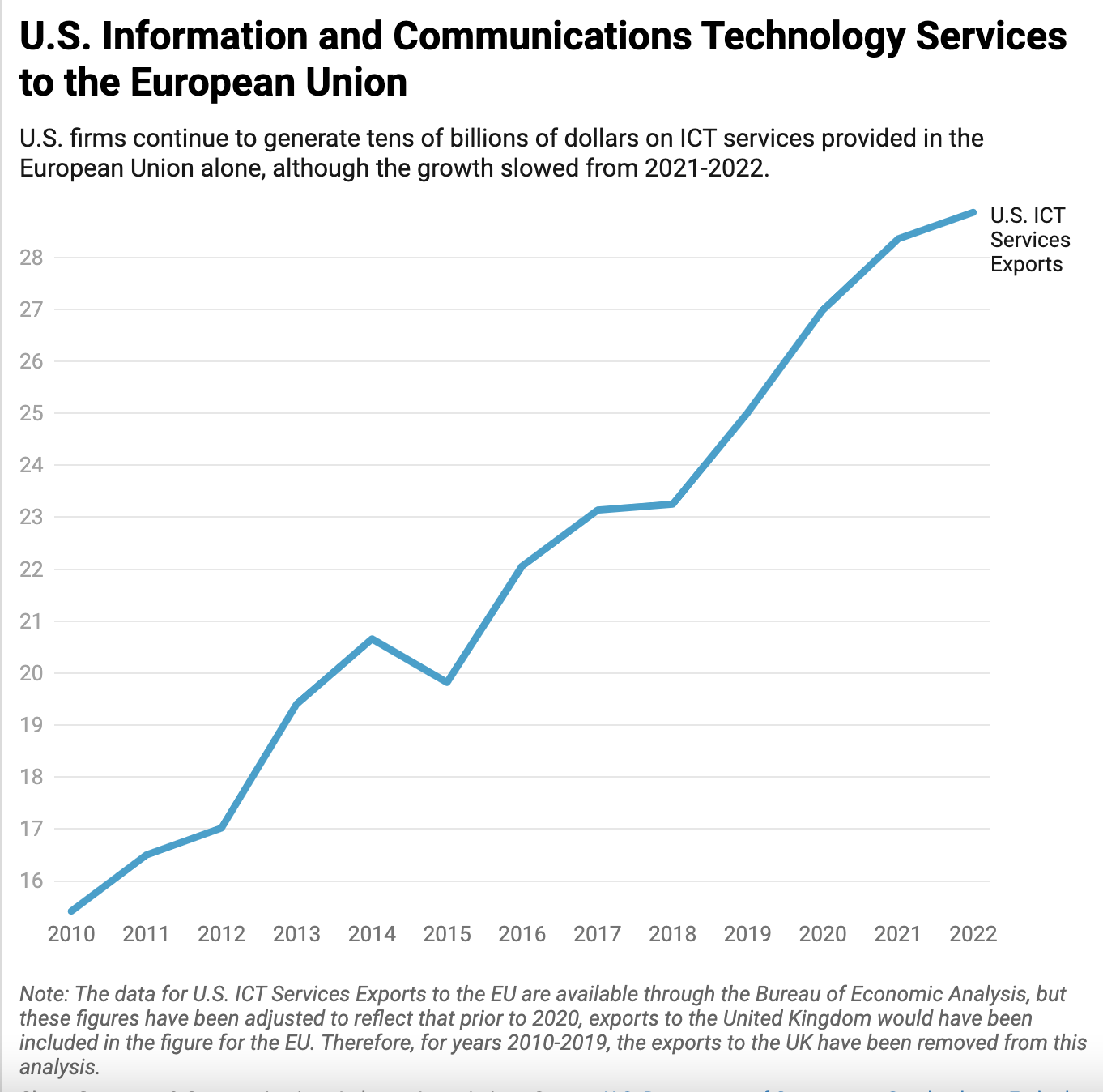The Digital Economy Should be Front and Center for the Indo-Pacific Economic Framework
The digital economy adds trillions of dollars to the Gross Domestic Product of the United States yearly, but its continued success will rely on cooperation with global partners. The U.S. foray into the Indo-Pacific region to fortify those ties represents a significant opportunity to do just that.
On May 23, U.S. President Joe Biden announced the launch of the Indo-Pacific Economic Framework (IPEF). The initiative brings the United States together with thirteen countries (and counting) to establish a partnership to strengthen economic growth and national security. The framework includes four pillars that target policy alignment in trade, supply chain resiliency, clean energy and infrastructure, and tax and anti-corruption. The countries will decide which of the four pillars they would like to join as details of the commitments and provisions are solidified between the parties over several weeks.
On the trade pillar, the IPEF will facilitate conversations seeking “high-standard rules of the road in the digital economy, including standards on cross-border data flows and data localization,” according to a fact sheet released by the White House. Other trade-specific goals include the pursuit of collaborations in e-commerce to stimulate the activity of small and medium sized enterprises, while also tackling issues related to “online privacy and discriminatory and unethical use of Artificial Intelligence.” Illustrative of the focus on digital economy issues in the Administration’s talking points, U.S. Trade Representative Katherine Tai labeled provisions related to the digital sector as those which “in particular best [represent] an area where we need to work with our IPEF partners, given the prominent role it plays in today’s global marketplace,” and further committing to “address issues in the digital economy that will help build connectivity and trust between key markets, including standards on cross-border data flows and data localizations.”
The Digital Economy is a Powerhouse in the U.S. and Should be Empowered through the Framework
The early signs from the White House and partner nations to the IPEF are promising for the future of digital trade and the associated widespread economic and societal benefits.
However, strong commitments will be necessary for the IPEF to deliver on its stated promises and to further economic growth throughout the region. The digital sector represents a thriving export market for the United States, a key source of the country’s economic might, and a central pillar to the country’s soft and hard power globally.
The Indo-Pacific region represents a major market for the U.S. economy both in the future and today. The twelve founding countries of the IPEF were responsible for bringing in $68.7 billion in 2020 for U.S. information and communications technologies (ICT) services exports and potentially ICT-enabled services exports. That number is likely higher, both because it does not include Fiji, a country for which the Bureau for Economic Analysis does not provide country-level data, and because the BEA did not publish export and import figures for certain countries to “avoid the disclosure of data of individual companies.”
The Asia and Pacific region made up 30.4 percent of all of the ICT services exports and 23.5 percent of all of the potentially ICT-enabled services exports for the United States in 2020. In all, the Asia and Pacific region brought in roughly $144.7 billion in ICT services and potentially ICT-enabled services exports in 2020 (this removes China from the total, as the country is unlikely to join the IPEF).
The United States is a key market for Indo-Pacific countries as well, as ICT services imports and potentially ICT-enabled services imports to the U.S. from the twelve founding member countries totaled to at least $62 billion in 2020. Roughly 35 percent of all of the ICT services imports and 25.7 percent of all potentially ICT-enabled services imports came from all Asia and Pacific countries in 2020.
This is only likely to grow in coming years with an expanded Indo-Pacific digital market, with some estimates predicting the number of Internet users in the region to expand to 3.1 billion by 2023.
In short, both the Indo-Pacific region economies and the United States should be highly incentivized to ensure they are operating from the same playbook when it comes to the rules, standards, and commitments that govern the digital economy. Internet governance fragmentation, censorship and restrictions of content, and data protectionism all represent existential threats to this global system of commerce that benefits both U.S. economic growth and the global economy.
Past Successes Should Guide the United States in IPEF’s Development
As the United States negotiates the trade provisions in the Indo-Pacific Economic Framework, officials should seek to incorporate the approaches of negotiating success of the past to advance its economic relationship with those in the Indo-Pacific Region. Agreements such as the digital trade chapter of the United States-Mexico-Canada Agreement (USMCA), the U.S.-Japan Digital Trade Agreement, as well as the eventually-abandoned Trans-Pacific Partnership (TPP) that eventually became the Comprehensive and Progressive Agreement for Trans-Pacific Partnership (CPTPP) should all serve as guides.
The United States should also take advantage of the fact that many IPEF partners have already signed onto the CPTPP and other regional digital trade pacts to secure strong protections for the digital economy. Although some of the commitments like those prohibiting data localization and ensuring cross-border data flows are more robust in the USMCA and U.S.-Japan pacts, Indo-Pacific governments have signaled a clear shared recognition of digital trade provisions and cooperation in the digital economy as necessary to boost all parties’ economies.
Aligning standards, cultivating an open digital economy featuring free flowing of data, and collaborating on internet standards and oversight with governments in the Indo-Pacific region are all key to the United States advancing its interests and fully unlocking the potential available in these markets through the IPEF. With that in mind, below are just some of the issues the United States should seek to address in the digital trade pillar of the IPEF:
- Enforceable and binding commitments broadly to ensure maximum efficacy of IPEF;
- Mechanisms that enable cross-border data flows and eliminate data localization mandates;
- Provisions that fight state censorship actions and rising digital authoritarianism;
- Commitments on good regulatory procedures that promote transparency and accountability in the development and implementation of regulations;
- Commitments not to pursue discriminatory taxation rules that target specific firms or industries, or those that depart from international standards;
- Initiatives to fortify the digital workforce development;
- Commitments to uphold strong encryption and other digital security measures;
- Agreement to pursue risk-based cybersecurity practices and ensuring certification approaches are not discriminatory in nature;
- Protection of the interoperable and interconnected nature of the internet and the upholding of non-discrimination and market access principles for networks;
- Enabling small and medium sized enterprises’ success in the digital economy in the region; and
- Long-standing commitments on copyright that reflect U.S. law and that will foster innovation in emerging technologies, to the extent intellectual property is included in the scope.
Additional priorities critical to continued economic growth and security such supply chain resiliency will be addressed in separate pillars. Several of these goals, such as cross-border data flows, taxation rules, and small and medium sized enterprises are named in the White House’s announcement. However, the specifics of the wording of commitments will be paramount to their ultimate success or failure. Due to the unique nature of the IPEF that allows countries to sign up or decline specific aspects of the agreement, the United States will also have to work closely with partners to ensure that as many countries as possible opt to join the digital trade pillar.
The Biden Administration Should Build on Recent Work in Bilateral and Multilateral Fora to Establish a Strong IPEF
The formation of the Indo-Pacific Economic Framework tracks with the Biden administration’s trade and economic empowerment strategy so far—forge improved ties with allies to facilitate cooperation through collaboration including but beyond the realm of trade. The foundation of the idea is to fortify connections with partners and, in doing so, identify and pursue mutually-beneficial policies that all parties are incentivized to take.
The EU-U.S. Trade & Technology Council is a prime example of this method in action. The effort, launched between the two parties in 2021, recently met for the second time and released a series of shared commitments—largely surrounding export controls and supply chain issues related to Russia’s invasion of Ukraine—and the conclusions from several working groups assigned to take on a variety of issues central to the digital economy.
The details that eventually make up the IPEF will have wide-ranging implications beyond the region as well. The Biden administration is reportedly seeking to employ the initiative as a template for its strategy going forward in Latin America as well, where the White House is seeking to reboot several trade pacts from the past several decades to account for technological changes.
The creation of fora to discuss policy agreements and disagreements such as the IPEF and TTC is key, however it will be critical that these initiatives lead to concrete outcomes including shared commitments that will facilitate trade. This collaboration is needed now more than ever. Fresh concerns regarding a friendly environment to data flows and the export of digital service to the Indo-Pacific remain and a rise in digital authoritarianism threatens the future of a free and open Internet.
As the countries at the heart of IPEF court other nations to join and they finalize the details of its charter and commitments, provisions tailored to support the digital economy will be paramount for United States competitiveness and the resilience of the internet ecosystem globally.








